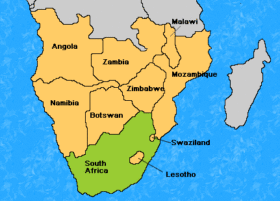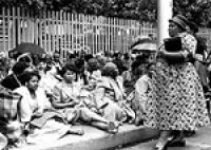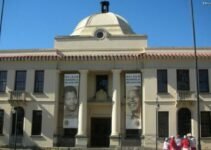As the sun paints the South African sky on April 9, the whispers of the past echo in the air. Like many threads woven into the nation’s vibrant tapestry, this date holds stories waiting to be unearthed. We embark on a journey of exploration, delving into the triumphs, tragedies, and turning points that mark April 9 in South Africa’s history.

2015: Rhodes statue removed at University of Cape Town
Following Chumani Maxwele’s radical protest through a political performance of throwing human excrement at the statue of Cecil John Rhodes situated on Rugby Road of the campus of the University of Cape Town, the statue was removed a month later on the 9 April 2015 at 17:37. The UCT Council voted upon the removal on the 8 April 2015 in consultation with Heritage Western Cape. The bronze statue had stood erect for eighty-one years serving as a dual representation of a figure that stimulated South Africa’s economy, but at the expense of the subjugation of Black people for the provision of cheap labour. The debate around the statue’s place on campus inspired the mobilization of protests, intense discourses, marches, sit-ins, and dialogue beneath the umbrella of the #RhodesMustFall movement, stimulated by Maxwele’s initial protest. The so-called ‘Fallists’ argued that the statue was significant beccause it connoted White supremacy, institutional racism, Black oppression and patriarchy that they argued were all still highly visible at the time. On this day, masses of students, academics, workers and community members gathered around the Jammie stairs, rugby fields, and Madiba circle to witness the removal of the statue. The fate of the statue following its removal was in the hands of Heritage Western Cape.
2010: South African woman, Janice Bronwyn Linden, is sentenced to death in China for smuggling drugs
On 9 April 2010, Janice Bronwyn Linden, 35 from Wentworth in Durban was sentenced to death by a high court in Guangdong Province, China for smuggling drugs. According to reports, on 30 November 2008 Linden arrived at the Baiyun International Airport, in Guangzhou without declaring any goods. After a normal search procedure, customs officers found 3kg of methamphetamine hydrochloride in her trunk. Linden was not the first person to be sentenced to death in China. Seven other South Africans have received the death sentences. Their sentences were suspended for two years on condition that they do not become involved in crime during that time behind bars. South Africa has close to 700 citizens in foreign prisons for drug related crimes. In the early hours of 12 December 2011, Linden was executed by lethal injection. In response, The South African International Relations Cooperations Department stated: “we have been very involved in the matter. We have been writing to the Chinese authorities, appealing to them to commute the sentence since we do not subscribe to the death penalty and she is a South African citizen.”
2005: NNP federal council decides to disband the party
In 2006, the New National Party disbanded and joined the African National Congress after a vote by its federal council.
2003: The first SARS case is suspected in South Africa
On 9 April 2003, a 62-year-old South African man was treated at a Pretoria hospital as a possible Severe Acute Respiratory Syndrome(SARS) case. The man arrived in South Africa from Hong Kong with no signs of being ill but after seven days he started to show flu-like symptoms and cough. When the doctors conducted tests the results came back negative, although he had all the signs of SARS. Media organisations reported that health officials were investigating how the disease is contracted and spread. Another theory had health officials looking into whether the SARS was actually a combination of viruses. If this case was confirmed, it would have been the first known case of SARS in South Africa. At the time, the number of deaths caused by SARS stood at least at 104 out of more than 2,600 cases worldwide.
1960: There is an assassination attempt on Verwoerd at the Rand Easter Show in Johannesburg
The first assassination attempt was made on the life of Prime Minister H.F. Verwoerd at the Rand Easter Show in Johannesburg. His assailant was a disgruntled White farmer, David Pratt, who fired two shots at the Minister at close range. Despite two bullets in his head, he miraculously escaped death. Verwoerd was murdered in 1966 by Dimitrio Tsafendas, a parliamentary messenger.
1926: John Davidson Rockerfeller, US philanthropist, donates $10 million towards the building of a museum in Cairo, Egypt
John Davidson Rockerfeller was an industrialist and a philanthropist who founded the Standard American Oil Company. Rockefeller family is one of the richest families in the world and are said to be wealthier than some countries. On 9 April 1926 Rockefeller donated $ 10 million towards the building of a museum in Cairo, Egypt. The family has carried on the legacy of Philanthropy with the Rockefeller Foundation spending millions towards Universities, Health care and Schools in the US and across the globe.
1901: Zulu army returns to Nongoma
During the Anglo-Boer War, Col. Bottomley ordered the Zulu army to assist the British. However, the project was terminated due to difficulties in feeding the 6,000 men and looting from Zulu kraals by some of the Zulus. Two Zulus were killed and 48,000 head of cattle were looted from the Boers during the expedition.
1860: Emily Hobhouse is born
Emily Hobhouse was a humanitarian who fought against British government policy in South Africa. She founded the South African Women and Children Distress Fund to collect money for Boer families and visited concentration camps in the Orange Free State and the Transvaal. Horrified by the conditions in the camps, she campaigned for change and assisted M.K. Gandhi in his passive resistance campaigns. Hobhouse is celebrated for her efforts towards the rights of South African families, both Black and White. Her ashes were scattered at the unveiling of the Woman’s Monument in Bloemfontein after she passed away in 1926.
1820: The first British Settlers arrive in Algoa Bay
In 1820, the first British Settlers arrived in Algoa Bay (now Port Elizabeth) on board of twenty-one ships. They numbered about 4500 and were placed on the eastern border of the Cape Colony to strengthen the border against incursions by hostile Xhosa societies. Their primary task was to build more permanent abodes for their families and till the lands. Eventually, they started to drift towards towns where they established schools, churches, and businesses.



